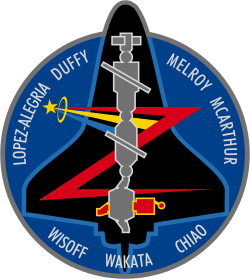Peter Jeffrey Wisoff
| Peter Jeffrey Wisoff | |
|---|---|
 Peter Jeffrey Wisoff | |
| Astronaut NASA | |
| Státní příslušnost | |
| Datum narození | 16. srpna 1958 (64 let) |
| Místo narození | Norfolk, Virginie |
| Předchozí zaměstnání | vědec fyzik |
| Čas ve vesmíru | 44 dní, 8 hodin a 9 minut |
| Kosmonaut od | 1990 |
| Mise | STS-57, STS-68, STS-81, STS-92 |
| Znaky misí | |
| Kosmonaut do | 2001 |
| Některá data mohou pocházet z datové položky. | |
Peter Jeffrey Wisoff (* 16. srpna 1958 Norfolk, Virginie), je americký vědec – fyzik a astronaut. Ve vesmíru byl čtyřikrát.
Život
Studium a zaměstnání
Vystudoval fyziku na univerzitách University of Virginia a Stanford University. Studium ukončil získáním doktorátu v roce 1986.
V letech 1990 až 1991 absolvoval kosmonautický výcvik v Houstonu v NASA a do roku 2001 byl členem jednotky kosmonautů. Po ukončení kariéry kosmonauta pracoval u společnosti Lawrence Livermore National Laboratory.
Oženil se, jeho ženou se stala astronautka Tamara Jerniganová. Má přezdívku Jeff.
Lety do vesmíru
Na oběžnou dráhu se v raketoplánech dostal čtyřikrát, vždy jako letový specialista a strávil ve vesmíru 44 dní, 8 hodin a 9 minut. Byl 294 člověkem ve vesmíru. Absolvoval tři výstupy do volného vesmíru (EVA) v délce 19 hodin a 53 minut.
- STS-57 Endeavour (21. června 1993 – 1. července 1993)
- STS-68 Endeavour – (30. září 1994 – 11. říjen 1994)
- STS-81 Atlantis (12. ledna 1997 – 22. ledna 1997)
- STS-92 Discovery (11. října 2000 – 24. října 2000)
Odkazy
Externí odkazy
 Obrázky, zvuky či videa k tématu Peter Jeffrey Wisoff na Wikimedia Commons
Obrázky, zvuky či videa k tématu Peter Jeffrey Wisoff na Wikimedia Commons - Na webu Space
- Na webu MEK-Kosmo
Média použitá na této stránce
STS-57 Endeavour, Orbiter Vehicle (OV) 105, crew insignia (logo), the Official insignia of the NASA STS-57 mission, depicts the Space Shuttle Endeavour maneuvering to retrieve the European Retrievable Carrier (EURECA) microgravity experiment satellite. Spacehab -- the first commercial space laboratory -- is depicted in the cargo bay (payload bay (PLB)), and its characteristic shape is represented by the inner red border of the patch. The three gold plumes surrounded the five stars trailing EURECA are suggestive of the United States (U.S.) astronaut logo. The five gold stars together with the shape of the orbiter's mechanical arm form the mission's numerical designation. The six stars on the American flag represent the U.S. astronauts who comprise the crew. With detailed input from the crewmembers, the final artwork was accomplished by artist Tim Hall. The names of the STS-57 flight crewmembers are located along the border of the patch. They are Commander Ronald J. Grabe, Pilot Brian J.
The crew patch for STS-81 , the fifth Shuttle-Mir docking mission, is shaped to represent the Roman numeral V. The Shuttle Atlantis is launching toward a rendezvous with Russia's Mir Space Station, silhouetted in the background. Atlantis and the STS-81 crew spent several days docked to Mir during which time Jerry M. Lineger (NASA-Mir-4) replaced astronaut John Blaha (NASA-Mir-3) as the U.S. crew member onboard Mir. The U.S. and Russian flags are depicted along with the names of the shuttle crew.
Peter Wisoff US astronaut
Designed by the crew members, the STS-92 patch symbolizes the second mission to carry U.S.-built elements to the International Space Station (ISS) for assembly. The black silhouette of the Space Shuttle Discovery stands out against the deep blue background of space in low Earth orbit. In the foreground in gray is a profile view of the ISS as it appears when the shuttle and crew arrive, with the station consisting of the Unity node, its two pressurized mating adapters (PMA), the Zarya functional cargo block, the Zvezda service module, and the Progress cargo vehicle.
Following the shuttle's rendezvous and docking, the ISS configuration will be augmented by the two elements delivered by Discovery–the Z1 truss and PMA-3. These two elements, depicted in red, will be installed using the shuttle's robot arm and be connected to ISS during four spacewalks. The multi-national nature of both the STS-92 crew and the ISS are reflected in the multi-colored Astronaut Office symbol.
STS-68 Mission Insignia





